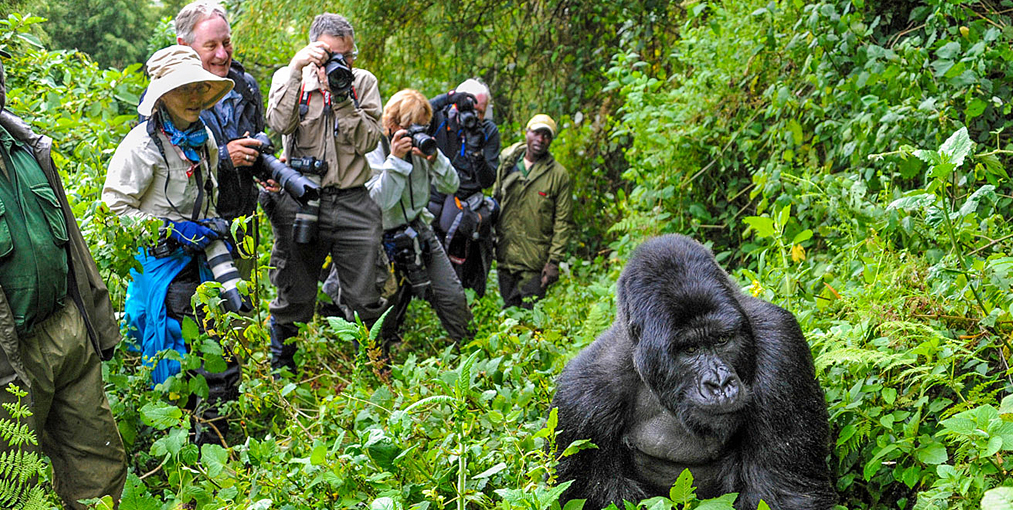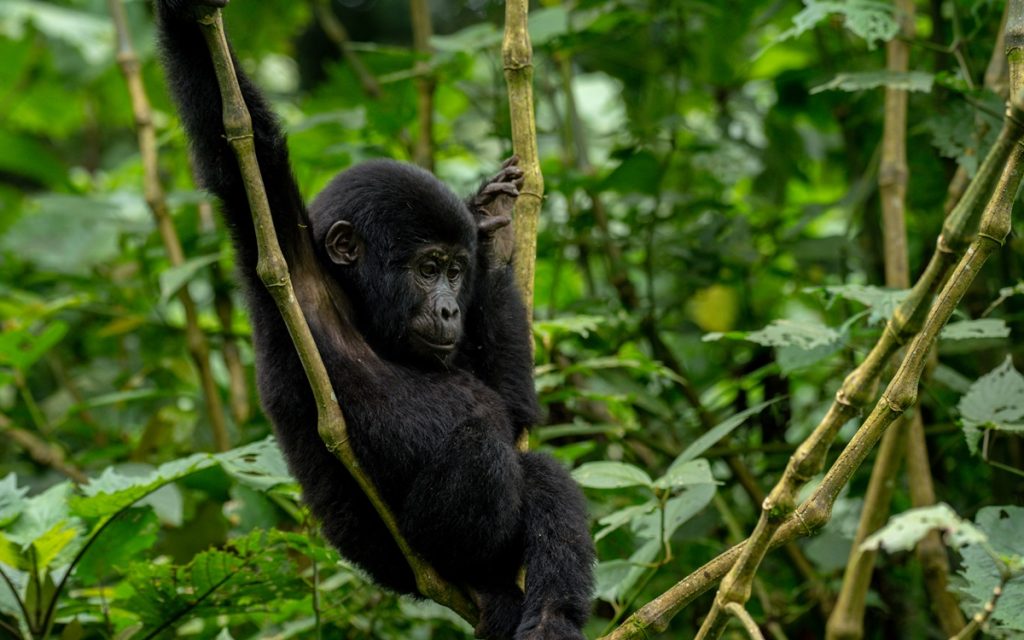- Written by: Anthony
- April 27, 2025
Gorilla Life span – How long do gorillas live?
Gorilla Life span – How long do gorillas live?
If you prefer the shortest answer, a gorilla lifespan is normally between 35 and 40 years when living in their natural wild habitat however, in captivity, the same gorilla may even live up to 50 years or more.
In fact the oldest ever lived gorilla was 67 years. Fatou is the oldest gorilla ever known gorilla to have lived up to that age.
Gorillas are one of our closest ape relatives in the animal kingdom, they are similar to humans in many ways such as; intelligence, social behavior, and strength.
Gorillas share 98% DNA with human beings and this is the major reason for referring to these gentle giants as human relatives.
A deeper understanding about gorillas, reveals that they are closest to humans than you may think.
To better understand the lifespan of a gorilla as compared to other wild animals, many people ask: how long do gorillas live? The answer is simple. It depends on their environment, species, and the challenges they face in the wild or captivity.
In this guide, you shall learn all you need to know regarding the lifespan of gorillas, as I break down all factors that contribute greatly to the gorilla longevity. We shall also deeply tackling the differences between gorilla in the wild natural habitat and gorillas living in captive habitats.

sleeping gorilla in the nest
How Long Do Gorillas Live?
The average lifespan of a gorilla varies depending on the gorilla environment, whether they live in their natural habit or captivity:
Natural habitat (In the wild): Gorillas typically live between 35 and 40 years. Their survival is influenced by food availability, health, and threats like predators or habitat destruction.
In captivity: Gorillas can live beyond 50 years due to controlled environments, medical care, and a steady food supply.
The contrast between wild and captive lifespans highlights how external factors shape their lives. While gorillas living in captivity such as zoo gorillas benefit from human care, those in the wild face a much harsher reality.
Factors That Influence Gorilla Lifespan
To understand why gorillas, live as long as they do, it’s essential to look at the factors that impact their survival.
Diet: Gorillas are herbivorous, meaning they primarily feed on vegetation leaves and stems – hence the most important reason for the lifespan.
Gorilla diet supports their large body size and energy needs but requires a vast and consistent supply of vegetation. Habitat destruction reduces access to these resources, shortening their lifespan.
Habitat: Gorillas live in forests and mountainous regions, primarily in Central’s Congo, Central African Republic and East Africa’s Uganda and Rwanda.
The quality and stability of their habitat directly influence their lifespan. Habitat loss due to agriculture, mining, and deforestation is one of the leading causes of declining gorilla populations.
Social Structure: Gorillas live in family groups led by a dominant silverback male. Since these groups can have up to 50 members, it offers significant level of security and protection from predators and more.
Younger gorillas learn survival skills from older members.
Strong social bonds attained from the family-based structure reduces stress and improve overall health, indirectly contributing to a longer lifespan.
In captivity, access to veterinary care allows for prompt treatment, significantly extending their lives.
Suggested Safari Itineraries
4 Days Rwanda Gorilla Tour and Golden Monkey Trekking
$ 2500
per personGorilla Lifespan based on Gorilla Species
| Species | Sub species | Wild lifespan | Lifespan in captivity |
| Eastern gorilla | Mountain gorilla | 35 years | 50 years or more |
| Eastern gorilla | Grauer’s Gorilla | 35 years | 50 or more |
| Western gorilla | Lowland gorilla & Cross river gorillas | 40 years | 50 plus |
Mountain gorillas often have shorter lifespans due to their harsh environment and greater exposure to threats, while Western Lowland Gorillas benefit from more favorable conditions.
Threats to Gorilla Lifespan
Despite their bravery and gentleness, gorillas face several threats that limit their lifespan especially in the wild. Some of these include the following:
Poaching: Gorillas are hunted illegally for bush meat or captured for the exotic pet trade. It’s even worse since gorilla parks aren’t fenced. Many people capture those infant gorillas for such unethical purposes.
Even in protected areas, poaching remains a problem due to weak enforcement of laws.
Habitat Loss: Many activities that destroy gorillas’ habitat such as deforestation, bush burning greatly affect gorilla lifespan.
As their habitat shrinks, gorillas are forced into smaller areas, leading to resource competition and stress.
Human Diseases: Gorillas are susceptible to human diseases, when a gorilla captures human diseases such as flu, cold, Ebola or fever, it can greatly affect its lifespan.
Diseases introduced by humans, such as during eco-tourism, can spread quickly through groups and since they live in the wild, it’s rather hard to notice.
Efforts by conservation organizations aim to address these threats, but progress is slow.
Recommended Safaris
Gorilla lifespan in Captivity
Compared to living in the wild, gorillas stand a higher survival rate in captivity due to:
Regular veterinary care against Illnesses and injuries are treated promptly.
Balanced diets: Zoos and sanctuaries provide diets tailored to their nutritional needs.
Controlled environments: Gorillas in captivity don’t face predators or the stress of habitat loss, even they get to learn important life skills and get to become more intelligent.
These factors allow gorillas to live longer lives. A notable example is Fatou, a Western Lowland Gorilla who lived to 60 years at the Columbus Zoo, making her the oldest recorded gorilla.
Conclusion
The gorilla’s lifespan majorly depends on its environment, sub species and a few their factors like predators.
While wild gorillas live an average of 35 to 40 years, in captivity some gorillas have been recorded to live for 50 years and even more.
However, the gorillas’ lifespan has unfortunately been greatly affected by practices such as habitat destruction, poaching, and human disease that continue to challenge their survival in the wild.
Because of this, there are very few gorillas remaining in the wild.
At Friendly Gorillas Safaris, we are happy to arrange an exciting gorilla safari to see these endangered primates in their natural habitat.
Anthony

Ready for your ultimate wildlife experience?
Chat with us, our team is always here to help!
You may also like …

Got any questions
about traveling to Uganda?
Get in touch.








